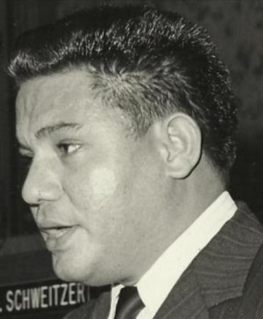 |
|---|
| Constitution |
Members of the Legislative Assembly of Western Samoa were elected on 15 November 1957. The 46 members consisted of 41 Samoans elected in single-member constituency and five Europeans elected from a nationwide constituency.
 |
|---|
| Constitution |
Members of the Legislative Assembly of Western Samoa were elected on 15 November 1957. The 46 members consisted of 41 Samoans elected in single-member constituency and five Europeans elected from a nationwide constituency.

American Samoa Community College (ASCC) is a public land-grant community college in the village of Mapusaga, American Samoa. Only legal residents of American Samoa who have graduated from high school or obtained a General Equivalency Diploma are admitted to ASCC.

Fiamē Mataʻafa Faumuina Mulinuʻu II was a Western Samoan paramount chief and politician. The holder of the Mataʻafa title, one of the four main Samoan chieftainships, he became the first prime minister of Western Samoa in 1959, serving until 1970. He held the position again from 1973 until his death in 1975.

The Legislative Assembly, also known as the Parliament of Samoa, is the national legislature of Samoa, seated at Apia, where the country's central administration is situated. Samoan Parliament is composed of two parts: the O le Ao o le Malo and the Legislative Assembly.
Matautu is the name of different villages in Samoa. Places named Matautu are found on the two largest islands, Upolu and Savai'i.

Sapapaliʻi is a village on the north east coast of Savaiʻi island in Samoa. It is the village where John Williams, the first missionary to bring Christianity to Samoa landed in 1830. Sapapali'i is in the Fa'asaleleaga political district and has a population of 896.

Safotu is a village on the central north coast of Savai'i island in Samoa. Safotu is in the district Gagaifomauga and has a population of 1270. Traditionally, it attained the status of 'Pule,' customary political authority, and has been the main centre of the Gagaifomauga district.
Vailele is a village situated on the central north coast of Upolu island in Samoa.
Malie is a village on the island of Upolu in Samoa. It is located on the north coast in the Electoral Constituency of Sagaga Le Usoga which forms part of the larger political district of Tuamasaga. The village has been a traditional headquarters for the Malietoa, one of the four paramount families and royal titles of Samoa. The village has a population of 2247.

General elections were held in Western Samoa on 4 April 1964, the first since independence in 1962. All candidates ran as independents. Following the elections, Fiame Mata'afa Faumuina Mulinu'u II remained Prime Minister.

The Chief Justice of Samoa is the chief justice of the Supreme Court of Samoa. The qualifications and powers of the office are governed by Part VI of the Constitution of Samoa and the Judicature Ordinance 1961. The position is currently held by Satiu Simativa Perese.
Malama Meleisea is a Samoan historian and the author of several historical books on Samoa. He holds the Samoan title Leasiolagi.

General elections were held in Western Samoa on 1 November 1944.
Thomas George Nauer, also known as Tofa Tōmasi, was a Western Samoan politician who served as a member of the Legislative Assembly between 1948 and 1953.

General elections were held in Western Samoa on 4 February 1961. They had originally been planned for November 1960, but were postponed by three months.
Tualaulelei Mauri was a Western Samoan chief and politician. He served as a member of the Legislative Council and Legislative Assembly between 1943 and 1961, and as Minister of Lands and Minister of Agriculture between 1956 and 1961.

Tuatagaloa Tofa Siaosi was a Western Samoan politician. He served as a member of the Legislative Assembly from 1967 until 1973 and was Minister of Finance between 1970 and 1973.
Toluono Lama was a Western Samoan politician. He was a member of the Legislative Assembly from 1973 to 1976.